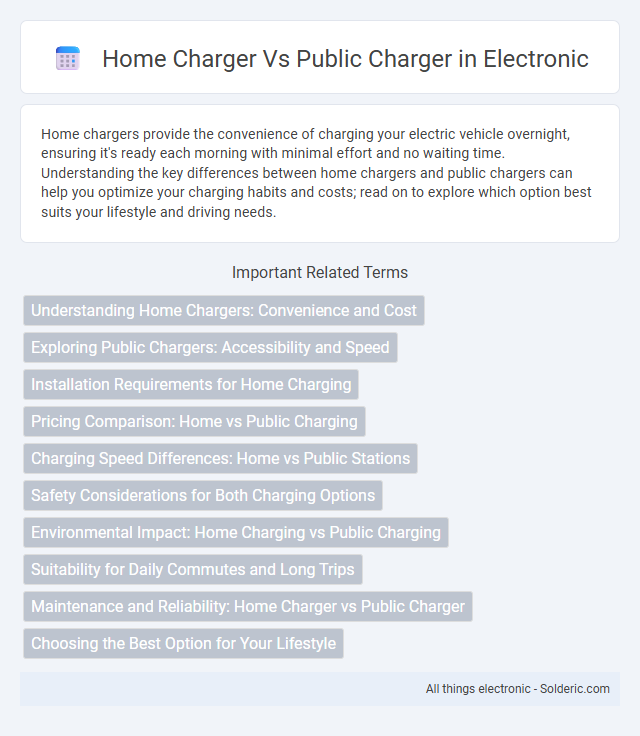Home chargers provide the convenience of charging your electric vehicle overnight, ensuring it's ready each morning with minimal effort and no waiting time. Understanding the key differences between home chargers and public chargers can help you optimize your charging habits and costs; read on to explore which option best suits your lifestyle and driving needs.
Comparison Table
| Feature | Home Charger | Public Charger |
|---|---|---|
| Location | Residential property | Commercial areas, parking lots |
| Charging Speed | 3.7 kW to 22 kW (Level 2) | Up to 350 kW (DC Fast Charging) |
| Cost | Installation fee + electricity cost | Pay-per-use or subscription |
| Availability | Always available at home | Dependent on station crowdedness |
| Convenience | Charge overnight, no wait | Quick top-ups, may require waiting |
| Installation | Requires professional installation | No installation needed for user |
| Best Use | Daily charging, long-duration | Long-distance travel, emergencies |
Understanding Home Chargers: Convenience and Cost
Home chargers offer unparalleled convenience by allowing EV owners to charge their vehicles overnight in a familiar environment, eliminating the need for frequent trips to public stations. The cost-effectiveness of home chargers is evident through lower electricity rates and the opportunity to take advantage of off-peak energy pricing, significantly reducing overall charging expenses. Unlike public chargers, home units provide consistent availability and faster charging speeds tailored to personal schedules, enhancing daily electric vehicle usage efficiency.
Exploring Public Chargers: Accessibility and Speed
Public chargers offer widespread accessibility in urban areas, shopping centers, and highway stops, facilitating convenient recharging for electric vehicle owners on the go. High-powered DC fast chargers typically deliver speeds ranging from 50 kW to over 350 kW, significantly reducing charging times compared to standard home chargers. The combination of multiple connector types, such as CCS, CHAdeMO, and Tesla Superchargers, ensures compatibility with a broad range of EV models.
Installation Requirements for Home Charging
Home charger installation requires a dedicated electrical circuit, a compatible wall-mounted charging unit, and professional electrician services to ensure safety and compliance with local codes. The process often involves upgrading the electrical panel, installing a 240-volt outlet or hardwired connection, and obtaining any necessary permits. Proper installation maximizes charging efficiency and supports the higher power demands of fast home charging.
Pricing Comparison: Home vs Public Charging
Home chargers typically offer lower electricity rates, resulting in more cost-effective charging compared to public chargers, which often charge higher per kWh fees or session-based pricing. Public chargers may include additional costs such as membership fees, parking, or idle fees, increasing the overall expense. You can save significantly on your electric vehicle's charging costs by installing a home charger, especially if you take advantage of time-of-use utility rates and overnight charging.
Charging Speed Differences: Home vs Public Stations
Home chargers typically offer slower charging speeds, ranging from 3.7 kW to 22 kW, suitable for overnight charging and convenience. Public chargers, especially fast chargers, can provide power levels from 50 kW up to 350 kW, enabling rapid charging in less than an hour. This significant difference in charging speed impacts electric vehicle usage patterns, with home charging ideal for daily top-ups and public chargers catering to long-distance travel needs.
Safety Considerations for Both Charging Options
Home chargers offer enhanced safety features like dedicated circuit breakers and controlled environments that reduce risks of electrical faults and overheating. Public chargers undergo regular maintenance and comply with strict industry standards to ensure user protection, but exposure to varying weather conditions and multiple users can introduce risks. Evaluating your safety preferences and convenience needs will help determine the best charging option for your electric vehicle.
Environmental Impact: Home Charging vs Public Charging
Home charging typically has a lower environmental impact due to the potential integration with renewable energy sources like solar panels, reducing reliance on fossil fuels. Public chargers often depend on grid electricity, which may still include a significant portion of non-renewable energy, increasing carbon emissions. Your choice between home and public charging can influence your vehicle's overall carbon footprint, making home charging a more eco-friendly option when coupled with green energy.
Suitability for Daily Commutes and Long Trips
Home chargers offer optimal convenience and efficiency for daily commutes, providing consistent overnight charging that fits regular mileage needs without interruption. Public chargers, especially fast chargers, are more suitable for long trips, enabling rapid energy replenishment during brief stops to maintain travel momentum. The strategic use of home charging for routine travel combined with public chargers for extended journeys maximizes both time and energy management.
Maintenance and Reliability: Home Charger vs Public Charger
Home chargers generally offer higher reliability due to private use and controlled environments, which reduce exposure to wear and environmental damage, resulting in lower maintenance needs. Public chargers experience higher usage rates and diverse user handling, increasing the frequency of malfunctions and requiring more regular maintenance to ensure consistent operation. Maintenance schedules for public chargers are typically more rigorous to address ongoing repairs and diagnostics, whereas home chargers benefit from simpler upkeep and fewer service interruptions.
Choosing the Best Option for Your Lifestyle
Home chargers offer convenience and cost savings by allowing you to charge your electric vehicle overnight in a familiar setting, ideal for daily commuting and predictable schedules. Public chargers provide faster charging speeds and greater flexibility, especially useful for long trips and when access to home charging is limited. Assess your driving patterns, access to home charging, and charging speed preferences to determine the best option for your lifestyle.
Home charger vs Public charger Infographic

 solderic.com
solderic.com